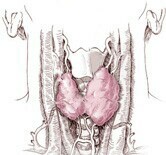Many cases involve low-risk tumors where treatments could carry greater risks than benefits
THURSDAY, Sept. 17, 2015 (HealthDay News) — Advanced imaging technology has increased diagnosis rates of thyroid cancer over the past decade; however, nearly one-third of these cases involve people with low-risk tumors, according to a Mayo Clinic study published in the September issue of Thyroid.
The study involved data on 566 men and women who were diagnosed with thyroid cancer in Olmsted County, Minn., between 1935 and 2012. The number of new cases of thyroid cancer doubled from 7.1 per 100,000 people between 1990 and 1999, to 13.7 per 100,000 people between 2000 and 2012. During this time period, the number of patients diagnosed with thyroid cancer who had symptoms of thyroid disease remained unchanged. In sharp contrast, the number newly diagnosed with the disease who had no related symptoms nearly quadrupled. The proportion of patients who die from thyroid cancer hasn’t changed since 1935.
Most often, silent cancers were diagnosed following the removal of thyroid tissue for a benign condition. Nineteen percent of patients were diagnosed after a tumor was incidentally detected during an imaging test, and 27 percent were diagnosed following investigations of nodules not associated with thyroid cancer that prompted doctors to order imaging tests of the neck.
“We are facing an epidemic of diagnosis in thyroid cancer,” study author Juan Brito Campana, M.B.B.S., an assistant professor of medicine at the Mayo Clinic in Rochester, Minn., said in a Mayo news release. “Now that we know where all these new cases are coming from, we can design strategies to identify patients with thyroid cancer who can benefit from our treatment without condemning other patients to unnecessary tests, treatment, suffering, and costs.”
Full Text (subscription or payment may be required)
Copyright © 2015 HealthDay. All rights reserved.








